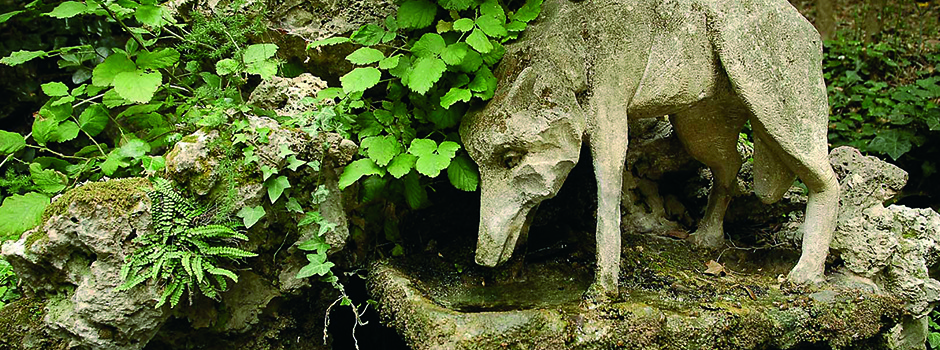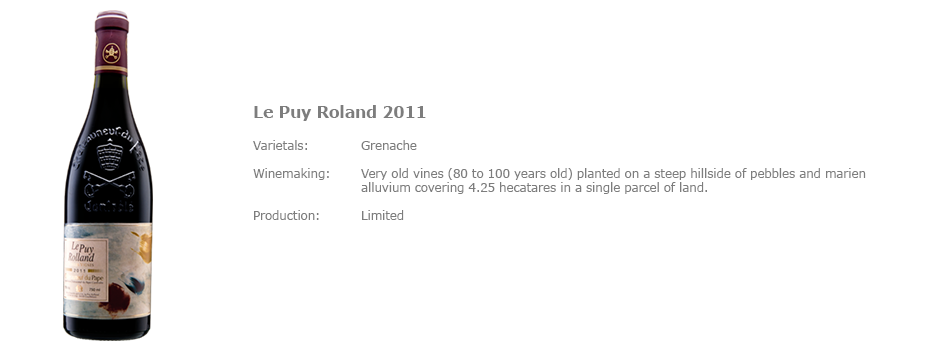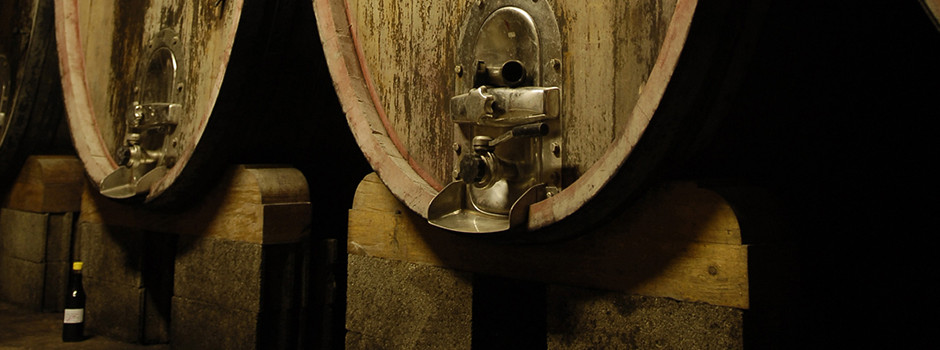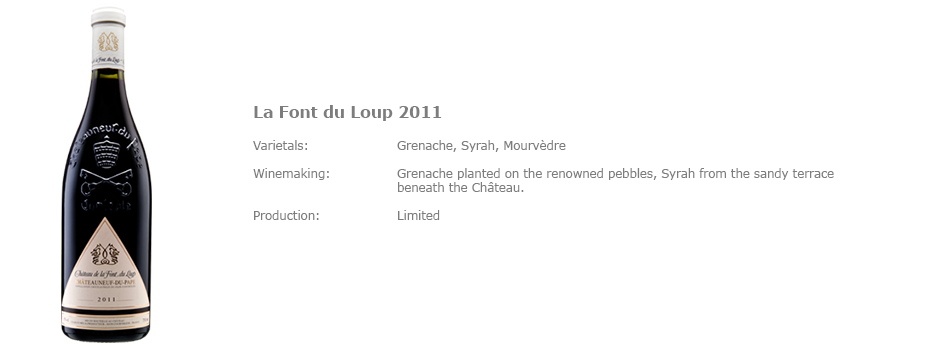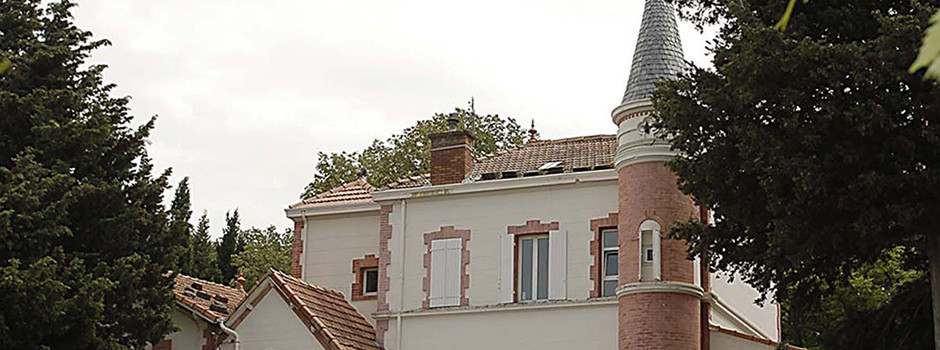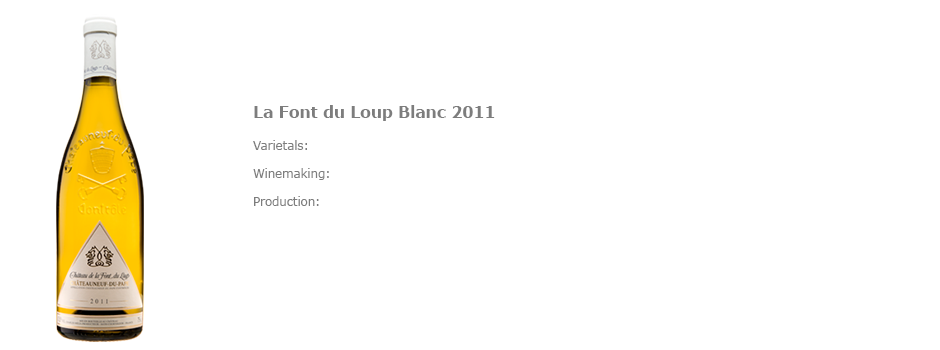La Font du Loup
Situated at the heart of the Chateauneuf du Pape Appellation, between Avignon and Orange, the castle La Font du Loup is set in the charming and convivial Provencal village Courthézon, a city of art and history. La Font du Loup is a family domain whose name already appeared on the Napoleonic land register.
This locality owes its name to the spring now situated at the heart of the domain. It’s one of the rare springs of the region that has not been exploited.
The legend has it that the wolves of the Mont Ventoux came to drink to this spring while they were going down to our Provencal plains. The people living in the surrounding villages called this place ‘La Font du Loup’ which means the fountains of the wolves.
Our attachment to history and to the traditions is found in our working methods, essentially inspired by the traditional discipline, and governed by draconian rules, their respect having contributed to the notoriety of the appellation:
– Constant improvement in the grapes quality.
– Wine maturing in accordance with its own characteristics.
– Bottling at the castle
The Soil
This is an original soil which has two alternating natures:
– on the one hand beautiful pebbles polished and worn away with time,
– on the other hand, presence of sand in a soil rich in alluvial deposits.
During the tertiary era, the soil was covered up by the sea which explains its actual composition. Through settling, sand, clay and limestone have formed the specific sub-layer of our soil.
Then, during the Quaternary which was the era of great glaciers above all else, the blocks torn down from the Alpine massif, dragged away by the powerful torrents due to the melting of the glaciers, settled on this first layer.
With time the blocks got polished to give these magnificent pebbles that make a marvellous asset to lead the maturation of the grapes.
The planted grape varieties are traditional. The red ones: four main grape varieties:
Grenache, Syrah, Mourvedre, Cinsault. The white ones: White Grenache, Clairette, Roussane, Bourboulenc.
The average lifetime of our vines is around 45 years with a very beautiful patch of Grenache that has an average lifetime of 90 years (le Puy Rolland). The domain’s average yield varies from 25 to 32 Hl/Ha.
The Methods
The respect of the environment has been a priority for a long time in La Font du Loup. This philosophy is found in our working methods that try to be the most possibly respectful and close to our soil.
Working the soil
The soils are worked through ploughing and hoeing, they are given 100% organic products by composting sheep and grape pomace manure. Otherwise, when it is possible, the grass is left in the parcels. By doing this, it improves the soil structure, its resistance to erosion and it also gives the possibility to limit the use of chemical product for weeding. Then, this is an ideal asset to keep and recreate a very useful ecosystem to struggle against the ravagers.
Protecting the vineyard
The grapevine is a cultivation that is one of the most sensitive to diseases and ravagers. Therefore, protecting it is a priority in the perpetuation of the domain. This protection must not be done to the detriment of the environment, this is why they turned towards a working method called “supervised control.” Combining modern and traditional techniques, this cultivating method is one of the keys to their success. The supervised control mingles in a limited and well-thought-out manner :
– Prevention
– Biological and biotechnological techniques
– Chemical products (when there is no other alternative)
It aims at maintaining the damages caused by the parasites under an acceptable threshold, while favouring the natural enemies of harmful organisms. In this perspective, they decided to treat the vine’s worms by sexual confusion. It consists in placing female hormones diffusers all over the vineyard: the disorientated male butterflies will not go fertilizing the females which will not go laying on the bunches of grapes. This is an efficient mean that exempts them from using chemical products.
Green working
Disdubbing is systematically done, in order to limit the harvest and make the next winter pruning easier.
Thinning out the leaves is done in July. By eliminating a part of the leaves situated in the fruit-bearing zone, it allows the improvement of the sanitary state of the crop, favouring the aeration of the bunches of grapes. The green harvest gives FDL the possibility to eliminate a part of the crop when nature is too generous.
Wine-making
Wine-making starts with the beginning of the harvest by controlling maturities (laboratory analysis) and tasting berries which allows them to decide about the exact date for the beginning of the crops.
It is essential to taste the grapes regularly during the harvest because a wine that stems from grapes which haven’t got any aromas, that are too ripe, or on the contrary not ripe enough, cannot be a great wine.
White grapes are only harvested during the morning in 25 kg boxes. Then, they are put in a cold room for the night to let them slightly macerate, which furthers a better aromatic extraction. The following morning, the grapes are put in our pneumatic press, they remain intact to be the most possibly respectful of this so fragile raw material.
The must obtained in this way is then placed in tanks where temperature is maintained under 12°C, in order to precipitate the roughest particles: this phenomenon is called the must settling. Once fermentation can begin, it takes effect on the clear juice that is obtained. It is done in new barrels and at temperatures that must not exceed 19°C. When the fermentation is over, the wine remains on thin lees for several months. During this period they make a regular stirring of the lees in the barrels to let them in suspension, thus bringing the richness, the complexity and the fatness of our wines.
The reds’ wine- making remains traditional. When the bins arrive, the crop is destemmed and put in tanks after a slight crushing of the grains. They have chosen a fragmented wine-making: to each parcel corresponds a tank, then it keeps all the typical character of the soil and the grape variety.
During the alcoholic fermentation, the tanks’ temperature is maintained between 28 and 30°C thanks to their cooling system. By prohibiting the use of commercial yeast, and only using natural yeast found on the grape’s skin and in the cellar, they preserve the typical character of the soil. The vatting time lasts between 20 and 35 days according to the grape variety, the years and the expected result.
Chateauneuf du Pape 2011
Smoothness and elegance merge effortlessly in this superb wine. This is a sinewy wine that begins with power and focused, tart red fruits, predominantly raspberry and currant. Candied ripe cherry aromas add lovely grace notes indicative of rich, clean, natural acids . The stunning red fruits are polished and backed with details such as dried Provence herbs, and a tiny hint of mint. There is spice and tannins embodied in an elegant texture, which shows that the wine has been well oaked in used French barrels for more than 12 months, assuring a great aging potential.
Paring : Combines perfectly with beef, duck, or lamb with rosemary.
Open 1 hour before serving. Well adapted to ageing.
Grapes: 60% Grenache, 20% Syrah, 15% Mourvèdre and 5% Cinsault
Vines: 60 year old vines
Soil: sandy sediment soil 70% pebbles 30%
Orientation: north-facing
Harvest: from 22 September to 8 October
Production: 29,000 bottles
Le Puy Rolland 2011
Elegant and concentrated, this wine has a nice mineral character, along with intense cocoa and dark plum skin flavors. It’s juicy, medium-bodied and rich without being over the top, balancing dark-chocolate-covered blackberries and blueberries with more complex savory notes such as spice and leather. While it’s a quiet big hulking wine at first, the finish shows great elegance and finesse, ending with silky tannins.
Pairing : Prime-cut beef with shallots, green pepper steak, pork with tomatoes and peppers (pipérade), stuffed mushrooms and ripe cheeses.
Grapes: 100% Grenache
Vines: 100 year old vines
Orientation: one single parcel of 4,25 ha, north facing
Soil: mixed of sandy sediments and pebbles
Harvest: 25 through 30 September
Production: 7,000 bottles

